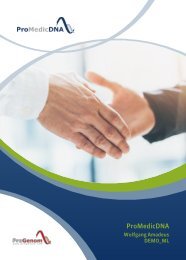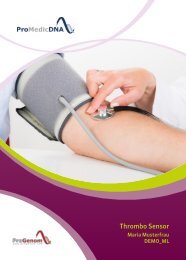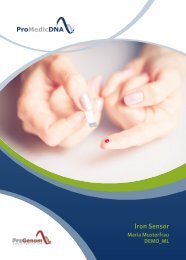ProVitalDNA - Package - DEMO EN
non-medical analysis - ProVitalDNA
non-medical analysis - ProVitalDNA
Create successful ePaper yourself
Turn your PDF publications into a flip-book with our unique Google optimized e-Paper software.
PPARG - Peroxisome proliferator-activated receptor gamma (rs1801282)<br />
Peroxisome proliferator-activated receptor gamma (PPAR-γ or PPARG), also known as the glitazone receptor, or NR1C3 (nuclear<br />
receptor subfamily 1, group C, member 3) is a type II nuclear receptor that in humans is encoded by the PPARG gene. PPARG<br />
regulates fatty acid storage and glucose metabolism. The genes activated by PPARG stimulate lipid uptake and adipogenesis by<br />
fat cells. PPARG knockout mice fail to generate adipose tissue when fed a high-fat diet.<br />
RES Genotype POP Possible results<br />
X C/C 86% Increased sensitivity to fat<br />
Genetic predisposition to excessive weight (OR: 1.38)<br />
References<br />
C/G 12% Stronger Yo-Yo effect<br />
Increased risk for fat deposits around the organs<br />
Increased weight loss though calory reduction<br />
Genetic predisosition to excessive weight (OR: 1.19)<br />
Better response to physical activity<br />
G/G 2% Stronger Yo-Yo effect<br />
Increased risk for fat deposits around the organs<br />
Increased weight loss though calory reduction<br />
No genetic predisosition to excessive weight<br />
Better response to physical activity<br />
Clin Genet. 2003 Feb:63(2):109-16. The PPAR-gamma P12A polymorphism modulates the relationship between dietary fat intake and components of<br />
the metabolic syndrome: results from the Québec Family Study. Robitaille J, Després JP, Pérusse L, Vohl MC.<br />
Obesity (Silver Spring). 2006 Apr:14(4):529-644. The human obesity gene map: the 2005 update. Rankinen T, Zuberi A, Chagnon YC, Weisnagel SJ,<br />
Argyropoulos G, Walts B, Pérusse L, Bouchard C.<br />
Diabetologia. 2005 Aug:48(8):1503-9. Epub 2005 Jun 29. Influence of Pro12Ala peroxisome proliferator-activated receptor gamma2 polymorphism on<br />
glucose response to exercise training in type 2 diabetes. Adamo KB, Sigal RJ, Williams K, Kenny G, Prud'homme D, Tesson F.<br />
Diabetes. 2002 Aug:51(8):2581-6. Association of the Pro12Ala polymorphism in the PPAR-gamma2 gene with 3-year incidence of type 2 diabetes and<br />
body weight change in the Finnish Diabetes Prevention Study. Lindi VI, Uusitupa MI, Lindström J, Louheranta A, Eriksson JG, Valle TT, Hämäläinen H,<br />
Ilanne-Parikka P, Keinänen-Kiukaanniemi S, Laakso M, Tuomilehto J: Finnish Diabetes Prevention Study.<br />
Horm Metab Res. 2005 Feb:37(2):99-105. Influence of the PPAR-gamma2 Pro12Ala and ACE I/D polymorphisms on insulin sensitivity and training<br />
effects in healthy offspring of type 2 diabetic subjects. Østergård T, Ek J, Hamid Y, Saltin B, Pedersen OB, Hansen T, Schmitz O.<br />
Franks PW et al. The Pro12Ala variant at the peroxisome proliferator-activated receptor gamma gene and change in obesity-related traits in the<br />
Diabetes Prevention Program. Diabetologia. 2007 Dec,50(12):2451-60. Epub 2007 Sep 27.<br />
Regina Brigelius-Flohé et al. Nutritional Genomics: Impact on Health and Disease. John Wiley & Sons, 21 Aug 2006<br />
ADRB2 adrenoceptor beta 2, surface (rs1042713)<br />
The beta-2 adrenergic receptor (β2 adrenoreceptor), also known as ADRB2, is a beta-adrenergic receptor within a cell membrane<br />
which reacts with adrenaline (epinephrine) as a hormone or neurotransmitter affecting muscles or organs. The ADRB2 gene is<br />
intronless. Different polymorphic forms, point mutations, and/or downregulation of this gene are associated with nocturnal<br />
asthma, excessive weight and type 2 diabetes. This receptor is directly associated with one of its ultimate effectors, the class C L-<br />
type calcium channel CaV1.2. This receptor-channel complex is coupled to the Gs G protein, which activates adenylyl cyclase,<br />
catalysing the formation of cyclic adenosine monophosphate (cAMP) which then activates protein kinase A, and the<br />
counterbalancing phosphatase PP2A.<br />
RES Genotype POP Possible results<br />
A/A 22% No effect<br />
X A/G 51% Stronger Yo-Yo effect<br />
References<br />
G/G 27% Stronger Yo-Yo effect<br />
Rudkowska I et al. Individualized weight management: what can be learned from nutrigenomics and nutrigenetics? Prog Mol Biol Transl Sci.<br />
2012,108:347-82.<br />
Masuo K, Katsuya T, Fu Y, Rakugi H, Ogihara T, and Tuck ML. Beta2- and beta3-adrenergic receptor polymorphisms are related to the onset of weight<br />
gain and blood pressure elevation over 5 years. Circulation 111: 3429-3434, 2005.<br />
Obesity (Silver Spring). 2006 Apr:14(4):529-644. The human obesity gene map: the 2005 update. Rankinen T1, Zuberi A, Chagnon YC, Weisnagel SJ,<br />
Argyropoulos G, Walts B, Pérusse L, Bouchard C.<br />
Masuo K et al. Rebound weight gain as associated with high plasma norepinephrine levels that are mediated through polymorphisms in the<br />
beta2-adrenoceptor. Am J Hypertens. 2005 Nov,18(11):1508-16.<br />
<strong>DEMO</strong>_ML Page 243 of 295


















